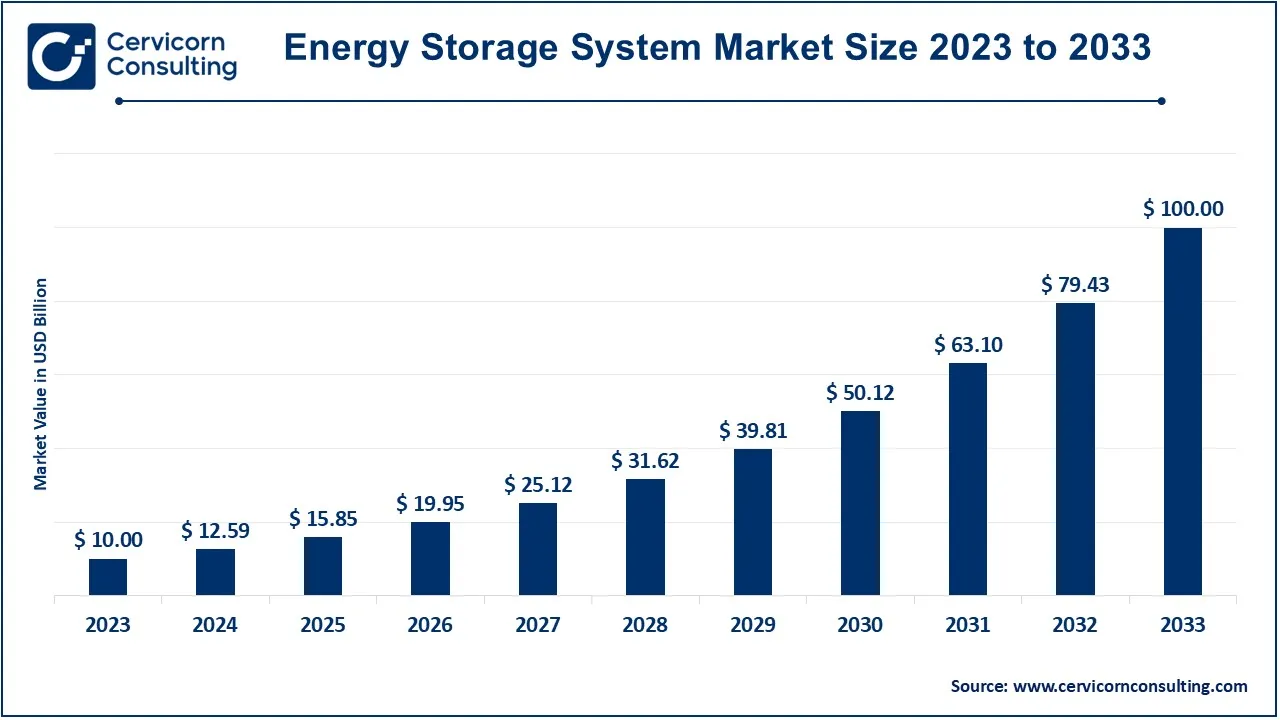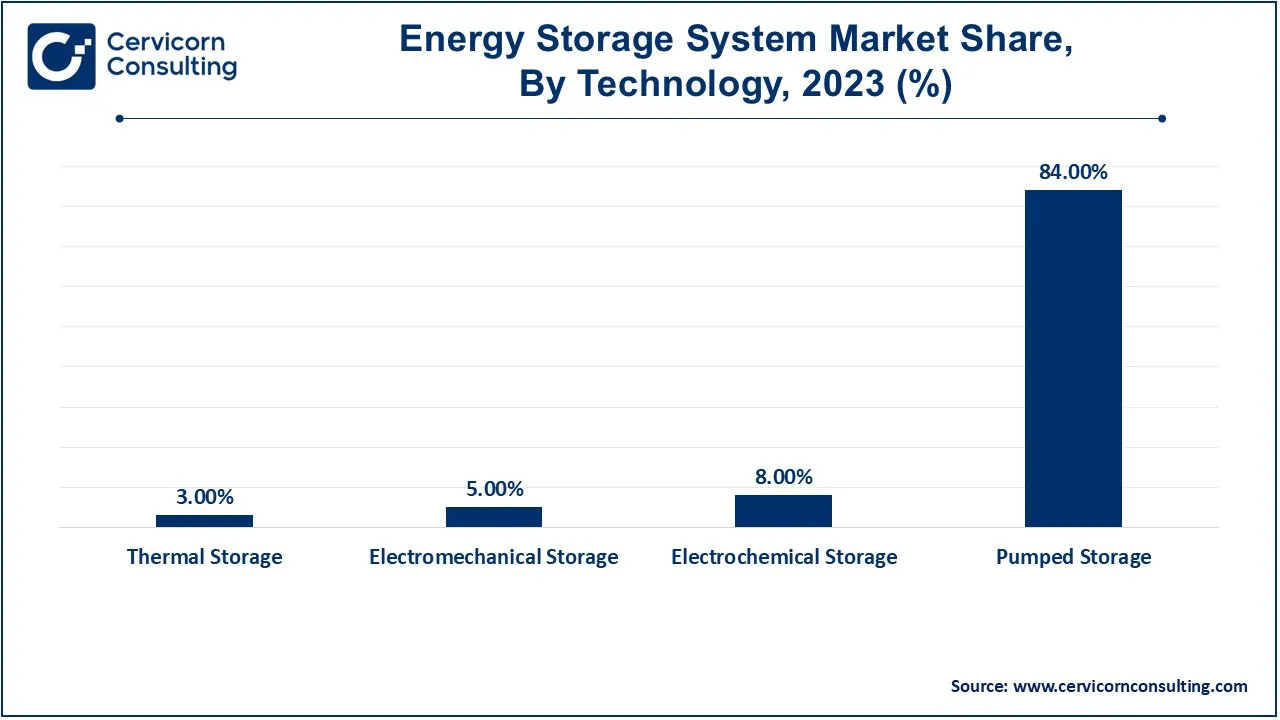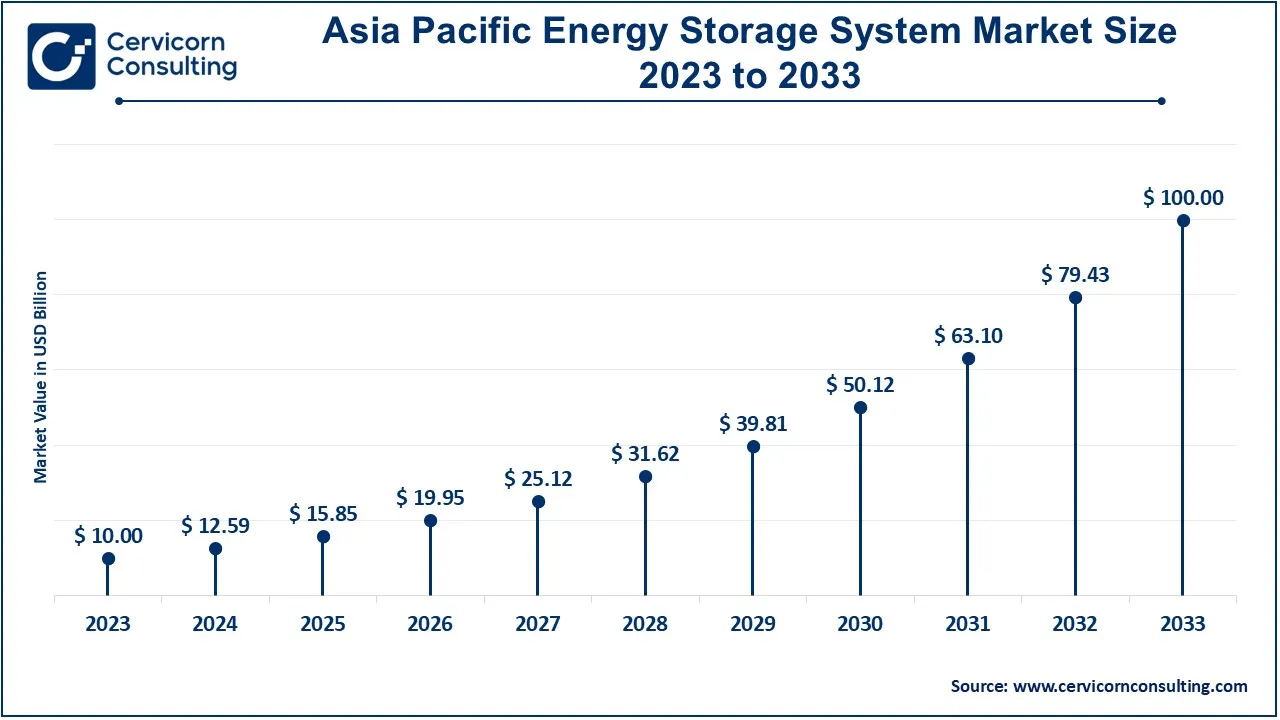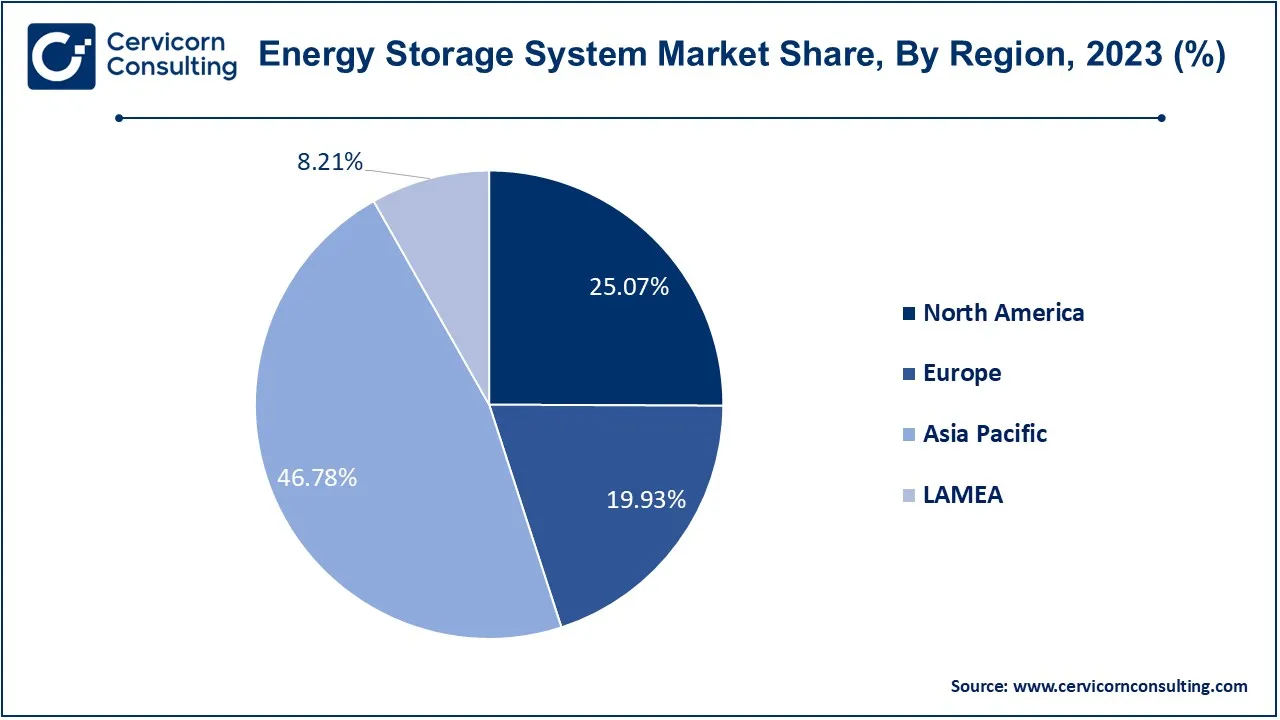The global energy storage system Market size was accounted at USD 551.15 billion in 2024 and is expected to reach around USD 1,893.64 billion by 2033, growing at a compound annual growth rate (CAGR) of 14.69% from 2024 to 2033.
The global energy storage system (ESS) market has seen significant growth, driven by the rising demand for renewable energy sources and the need for grid stability. As governments and industries push for cleaner, greener energy, ESS technologies are becoming essential for ensuring that renewable power can be stored and distributed efficiently. Additionally, the growing adoption of electric vehicles (EVs) is boosting the demand for advanced battery storage solutions. According to market reports, the global ESS market is expected to grow significantly, reaching billions of dollars in the next decade, with major investments in infrastructure and technology development. The market growth is not only fueled by renewable energy integration but also by the rising interest in decentralized energy systems. More consumers and businesses are turning to ESS to gain independence from the grid, reduce electricity costs, and ensure backup power. China's energy storage battery exports have seen substantial growth. From January to May 2024, the cumulative export volume reached 8.4 GWh, marking a year-on-year increase of 50.1%. Notably, in May alone, exports surged by 664% compared to the same month in the previous year.

The energy storage system (ESS) market encompasses technologies and solutions that store energy for later use, ensuring a reliable and efficient power supply. These systems include batteries, flywheels, compressed air, and thermal storage. ESS is crucial for balancing supply and demand, integrating renewable energy sources, and enhancing grid stability. Growth in the market is driven by increasing renewable energy adoption, advancements in battery technology, and supportive government policies. ESS applications range from residential and commercial use to large-scale grid support, contributing to energy efficiency, peak load management, and resilience against power outages.
Report highlights
Report Scope
| Area of Focus | Details |
| Market Size in 2024 | USD 551.15 Billion |
| Market Size by 2033 | USD 1,893.64 Billion |
| Market Growth Rate | CAGR of 14.69% from 2024 to 2033 |
| Largest Market | Asia Pacific |
| Fastest Growing Market | North America |
| Segment Coverage | By Technology, Application, End Use and Regions |
Decreasing Costs of Energy Storage Technologies:
Regulatory Mandates and Energy Security Concerns:
Limited Lifespan and Degradation Issues:
Complexity and High Initial Investment:
Advancements in Alternative Storage Technologies:
Integration with Renewable Energy Projects:
Regulatory and Standardization Issues:
Grid Integration and Infrastructure Limitations:
Pumped Storage: Pumped storage segment has registered highest market share of 84% in the year of 2023. Pumped storage is a type of hydroelectric power generation that stores energy by pumping water from a lower elevation reservoir to a higher elevation during low demand periods. It releases the stored water during high demand, generating electricity. Increased renewable energy integration drives the growth of pumped storage. Advancements in technology aim to enhance efficiency and reduce environmental impact, while regulatory support promotes large-scale projects to stabilize grids.

Electrochemical Storage: The electrochemical storage segment has covered market share of 8% in 2023. Electrochemical storage, primarily involving batteries like lithium-ion, stores and releases electrical energy through chemical reactions. It is widely used in applications ranging from consumer electronics to grid storage. Advancements in battery technology focus on increasing energy density, reducing costs, and improving safety. The rise of electric vehicles and renewable energy sources fuels demand, with significant investments in recycling and second-life applications for used batteries.
Electromechanical Storage: In 2023 electromechanical storage segment has recorded market share of 5%. Electromechanical storage includes technologies like flywheels and compressed air energy storage (CAES), which store energy in mechanical forms and convert it back to electricity when needed. Innovations aim to enhance the efficiency and durability of electromechanical systems. Flywheels are gaining traction for short-duration, high-power applications, while CAES is explored for large-scale storage, benefiting from improved materials and integration with renewable energy sources.
Thermal Storage: The thermal storage segment has calculated market share of 3% in 2023. Thermal storage involves storing energy in the form of heat, which can be used for heating or converted back to electricity. Common methods include molten salt and phase change materials. Growing adoption in concentrated solar power (CSP) plants and district heating systems drives thermal storage market. Research focuses on increasing storage capacity, reducing costs, and improving thermal efficiency. Hybrid systems combining thermal and other storage methods are also emerging to enhance grid reliability.
Stationary Energy Storage Systems: The stationary segment has captured dominating market share of 79% in 2023. Stationary energy storage systems are fixed installations designed to store energy for later use, often for grid support, renewable energy integration, or emergency backup. Key trends include increasing deployment of lithium-ion batteries, growing adoption of renewable energy sources, and government incentives promoting energy storage for grid stability. Innovations in battery technology and decreasing costs are driving market growth, along with rising demand for decentralized power solutions.
Transport: The transport segment has generated market share of 21% in the year of 2023. Transport energy storage systems refer to energy storage solutions used in electric and hybrid vehicles, including cars, buses, and trains. The transport segment is experiencing rapid growth due to the global shift towards electric mobility, advancements in battery technology, and stringent emission regulations. Major trends include the development of high-energy-density batteries, fast-charging solutions, and investments in electric vehicle infrastructure, driving the expansion of the electric vehicle market.
Residential: Residential segment has reported market share of 11% in 2023. Residential energy storage systems (ESS) store energy for homes, often used with solar panels to manage energy use and reduce electricity costs. Increased adoption of solar-plus-storage systems, driven by declining battery costs and rising energy independence. Smart home integration and demand for backup power during outages are also boosting the market.
Non-Residential: The non-residential segment has confirmed market share of 23% in 2023. Non-residential ESS include systems for commercial and industrial applications, providing energy management, demand charge reduction, and backup power. Growing emphasis on sustainability and energy efficiency, enhanced by corporate ESG goals. Microgrids and distributed energy resources are gaining traction, supported by advancements in battery technology and decreasing costs.
Utilities: The utilities segment has accounted market share of 66% in 2023. Utility-scale ESS are large systems used by electric utilities to store and distribute energy, improving grid stability and integrating renewable energy sources. Expansion driven by the need for grid modernization and renewable energy integration. Policies supporting clean energy and advances in battery technology are pivotal. Increased focus on long-duration storage solutions and frequency regulation capabilities.
Rapid industrialization and urbanization in Asia-Pacific drive the demand for robust energy storage solutions. Countries like China, Japan, and South Korea are leading in energy storage deployments, supported by significant investments in renewable energy projects and technological advancements. Asia Pacific market size is calculated at USD 258.10 billion in 2024 and is projected to grow around USD 886.79 billion by 2033. Government initiatives promoting energy security and the transition to cleaner energy sources are also key trends.

North America's energy storage system market is driven by supportive government policies, incentives, and regulatory frameworks. U.S market size is estimated to reach around USD 380.24 billion by 2033 increasing from USD 110.67 billion in 2024. Increasing investments in grid modernization, coupled with the rise in renewable energy installations, especially in the U.S. and Canada, are significant growth factors. There's also a notable trend towards adopting advanced battery technologies for residential and commercial use. U.S market size is estimated to reach around USD 380.24 billion by 2033 increasing from USD 110.67 billion in 2024.

In Europe, stringent environmental regulations and ambitious renewable energy targets propel the energy storage system market. The European Union's Green Deal and various national initiatives support large-scale energy storage projects. There's a strong focus on developing and integrating smart grid technologies and decentralized energy systems, enhancing grid flexibility and reliability. Europe market size is measured at USD 109.95 billion in 2024 and is expected to grow around USD 377.78 billion by 2033.
In LAMEA(Latin America, Middle East, and Africa), the energy storage market is growing due to the increasing need for reliable power supply and the integration of renewable energy sources. Solar power projects in the Middle East and Africa are particularly driving the demand for storage solutions. Additionally, economic development and rising energy access initiatives in Latin America are contributing to market expansion.
Companies like Energy Vault Holdings and Form Energy, Inc. are entering the market with innovative energy storage solutions, such as gravity-based systems and long-duration iron-air batteries, respectively. Tesla, Inc., LG Energy Solution Ltd., and Samsung SDI Co., Ltd. dominate the market due to their advanced lithium-ion battery technology, large-scale production capabilities, and extensive distribution networks. Their continuous investments in R&D and strategic partnerships further strengthen their market positions, enabling them to offer efficient, reliable, and scalable energy storage solutions.
Market Segmentation
By Technology
By Application
By End Use
By Regions
Chapter 1 Market Introduction and Overview
1.1 Market Definition and Scope
1.1.1 Overview of Energy Storage System
1.1.2 Scope of the Study
1.1.3 Research Timeframe
1.2 Research Methodology and Approach
1.2.1 Methodology Overview
1.2.2 Data Sources and Validation
1.2.3 Key Assumptions and Limitations
Chapter 2 Executive Summary
2.1 Market Highlights and Snapshot
2.2 Key Insights by Segments
2.2.1 By Technology Overview
2.2.2 By Application Overview
2.2.3 By End Use Overview
2.3 Competitive Overview
Chapter 3 Global Impact Analysis
3.1 COVID 19 Impact on Energy Storage System Market
3.1.1 COVID-19 Landscape: Pre and Post COVID Analysis
3.1.2 COVID 19 Impact: Global Major Government Policy
3.1.3 Market Trends and Opportunities in the COVID-19 Landscape
3.2 Russia-Ukraine Conflict: Global Market Implications
3.3 Regulatory and Policy Changes Impacting Global Markets
Chapter 4 Market Dynamics and Trends
4.1 Market Dynamics
4.1.1 Market Drivers
4.1.1.1 Decreasing Costs of Energy Storage Technologies
4.1.1.2 Regulatory Mandates and Energy Security Concerns
4.1.2 Market Restraints
4.1.2.1 Limited Lifespan and Degradation Issues
4.1.2.2 Complexity and High Initial Investment
4.1.3 Market Opportunity
4.1.3.1 Advancements in Alternative Storage Technologies
4.1.3.2 Integration with Renewable Energy Projects
4.1.4 Market Opportunity
4.1.4.1 Regulatory and Standardization Issues
4.1.4.2 Grid Integration and Infrastructure Limitations
4.2 Market Trends
Chapter 5 Premium Insights and Analysis
5.1 Global Energy Storage System Market Dynamics, Impact Analysis
5.2 Porter’s Five Forces Analysis
5.2.1 Bargaining Power of Suppliers
5.2.2 Bargaining Power of Buyers
5.2.3 Threat of Substitute Products
5.2.4 Rivalry among Existing Firms
5.2.5 Threat of New Entrants
5.3 PESTEL Analysis
5.4 Value Chain Analysis
5.5 Product Pricing Analysis
5.6 Vendor Landscape
5.6.1 List of Buyers
5.6.2 List of Suppliers
Chapter 6 Energy Storage System Market, By Technology
6.1 Global Energy Storage System Market Snapshot, By Technology
6.1.1 Market Revenue (($Billion) and Growth Rate (%), 2021-2033
6.1.1.1 Pumped Storage
6.1.1.2 Electrochemical Storage
6.1.1.3 Electromechanical Storage
6.1.1.4 Thermal Storage
Chapter 7 Energy Storage System Market, By Application
7.1 Global Energy Storage System Market Snapshot, By Application
7.1.1 Market Revenue (($Billion) and Growth Rate (%), 2021-2033
7.1.1.1 Stationary
7.1.1.2 Transport
Chapter 8 Energy Storage System Market, By End Use
8.1 Global Energy Storage System Market Snapshot, By End Use
8.1.1 Market Revenue (($Billion) and Growth Rate (%), 2021-2033
8.1.1.1 Residential
8.1.1.2 Non-Residential
8.1.1.3 Utilities
Chapter 9 Energy Storage System Market, By Region
9.1 Overview
9.2 Energy Storage System Market Revenue Share, By Region 2023 (%)
9.3 Global Energy Storage System Market, By Region
9.3.1 Market Size and Forecast
9.4 North America
9.4.1 North America Energy Storage System Market Revenue, 2021-2033 ($Billion)
9.4.2 Market Size and Forecast
9.4.3 North America Energy Storage System Market, By Country
9.4.4 U.S.
9.4.4.1 U.S. Energy Storage System Market Revenue, 2021-2033 ($Billion)
9.4.4.2 Market Size and Forecast
9.4.4.3 U.S. Market Segmental Analysis
9.4.5 Canada
9.4.5.1 Canada Energy Storage System Market Revenue, 2021-2033 ($Billion)
9.4.5.2 Market Size and Forecast
9.4.5.3 Canada Market Segmental Analysis
9.4.6 Mexico
9.4.6.1 Mexico Energy Storage System Market Revenue, 2021-2033 ($Billion)
9.4.6.2 Market Size and Forecast
9.4.6.3 Mexico Market Segmental Analysis
9.5 Europe
9.5.1 Europe Energy Storage System Market Revenue, 2021-2033 ($Billion)
9.5.2 Market Size and Forecast
9.5.3 Europe Energy Storage System Market, By Country
9.5.4 UK
9.5.4.1 UK Energy Storage System Market Revenue, 2021-2033 ($Billion)
9.5.4.2 Market Size and Forecast
9.5.4.3 UK Market Segmental Analysis
9.5.5 France
9.5.5.1 France Energy Storage System Market Revenue, 2021-2033 ($Billion)
9.5.5.2 Market Size and Forecast
9.5.5.3 France Market Segmental Analysis
9.5.6 Germany
9.5.6.1 Germany Energy Storage System Market Revenue, 2021-2033 ($Billion)
9.5.6.2 Market Size and Forecast
9.5.6.3 Germany Market Segmental Analysis
9.5.7 Rest of Europe
9.5.7.1 Rest of Europe Energy Storage System Market Revenue, 2021-2033 ($Billion)
9.5.7.2 Market Size and Forecast
9.5.7.3 Rest of Europe Market Segmental Analysis
9.6 Asia Pacific
9.6.1 Asia Pacific Energy Storage System Market Revenue, 2021-2033 ($Billion)
9.6.2 Market Size and Forecast
9.6.3 Asia Pacific Energy Storage System Market, By Country
9.6.4 China
9.6.4.1 China Energy Storage System Market Revenue, 2021-2033 ($Billion)
9.6.4.2 Market Size and Forecast
9.6.4.3 China Market Segmental Analysis
9.6.5 Japan
9.6.5.1 Japan Energy Storage System Market Revenue, 2021-2033 ($Billion)
9.6.5.2 Market Size and Forecast
9.6.5.3 Japan Market Segmental Analysis
9.6.6 India
9.6.6.1 India Energy Storage System Market Revenue, 2021-2033 ($Billion)
9.6.6.2 Market Size and Forecast
9.6.6.3 India Market Segmental Analysis
9.6.7 Australia
9.6.7.1 Australia Energy Storage System Market Revenue, 2021-2033 ($Billion)
9.6.7.2 Market Size and Forecast
9.6.7.3 Australia Market Segmental Analysis
9.6.8 Rest of Asia Pacific
9.6.8.1 Rest of Asia Pacific Energy Storage System Market Revenue, 2021-2033 ($Billion)
9.6.8.2 Market Size and Forecast
9.6.8.3 Rest of Asia Pacific Market Segmental Analysis
9.7 LAMEA
9.7.1 LAMEA Energy Storage System Market Revenue, 2021-2033 ($Billion)
9.7.2 Market Size and Forecast
9.7.3 LAMEA Energy Storage System Market, By Country
9.7.4 GCC
9.7.4.1 GCC Energy Storage System Market Revenue, 2021-2033 ($Billion)
9.7.4.2 Market Size and Forecast
9.7.4.3 GCC Market Segmental Analysis
9.7.5 Africa
9.7.5.1 Africa Energy Storage System Market Revenue, 2021-2033 ($Billion)
9.7.5.2 Market Size and Forecast
9.7.5.3 Africa Market Segmental Analysis
9.7.6 Brazil
9.7.6.1 Brazil Energy Storage System Market Revenue, 2021-2033 ($Billion)
9.7.6.2 Market Size and Forecast
9.7.6.3 Brazil Market Segmental Analysis
9.7.7 Rest of LAMEA
9.7.7.1 Rest of LAMEA Energy Storage System Market Revenue, 2021-2033 ($Billion)
9.7.7.2 Market Size and Forecast
9.7.7.3 Rest of LAMEA Market Segmental Analysis
Chapter 10 Competitive Landscape
10.1 Competitor Strategic Analysis
10.1.1 Top Player Positioning/Market Share Analysis
10.1.2 Top Winning Strategies, By Company, 2021-2023
10.1.3 Competitive Analysis By Revenue, 2021-2023
10.2 Recent Developments by the Market Contributors (2023)
Chapter 11 Company Profiles
11.1 Tesla, Inc.
11.1.1 Company Snapshot
11.1.2 Company and Business Overview
11.1.3 Financial KPIs
11.1.4 Product/Service Portfolio
11.1.5 Strategic Growth
11.1.6 Global Footprints
11.1.7 Recent Development
11.1.8 SWOT Analysis
11.2 LG Energy Solution Ltd.
11.3 Samsung SDI Co., Ltd.
11.4 Panasonic Corporation
11.5 Contemporary Amperex Technology Co. Limited (CATL)
11.6 BYD Company Ltd.
11.7 General Electric Company
11.8 Siemens AG
11.9 ABB Ltd.
11.10 Schneider Electric SE